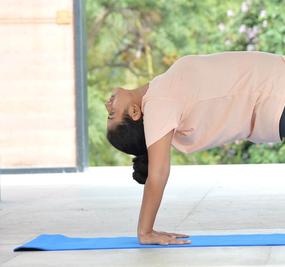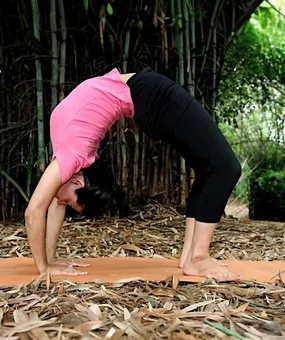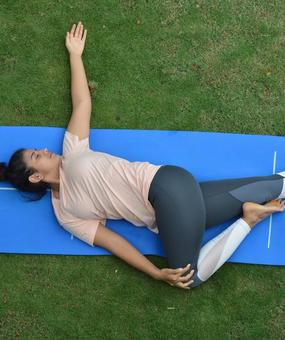Hal = plow, Asana = posture or pose
This yoga pose gets its name from the “plow”– a popular farming tool commonly used in Indian agriculture to prepare the soil for sowing crops. Like its namesake, this pose prepares the ‘field’ of the body and mind for deep rejuvenation. Halasana is pronounced as hull-ah-sa-na.
Parsva Halasana is an advanced variation of the Halasana.
How to do Halasana (Plow Pose): Steps
- Lie on your back with your arms beside you, palms downwards.
- As you inhale, use your abdominal muscles to lift your feet off the floor, raising your legs vertically at a 90-degree angle.
- Continue to breathe normally and supporting your hips and back with your hands, lift them off the ground.
- Allow your legs to sweep in a 180-degree angle over your head till your toes touch the floor. Your back should be perpendicular to the floor. This may be difficult initially, but make an attempt for a few seconds.
- Hold this pose and let your body relax more and more with each steady breath.
- After about a minute (a few seconds for beginners) of resting in this pose, you may gently bring your legs down on exhalation.
Halasana Video
Tips for Halasana
Do this asana slowly and gently. Ensure that you do not strain your neck or push it into the ground.
Support your back on the tops of your shoulders, lifting your shoulders a little towards your ears.
Avoid jerking your body, while bringing the legs down.
Preparatory asanas
- Poorva Halasana or the preliminary plow pose is a preparatory asana before you practice full Halasana pose. It is relatively easy to perform.
- Shoulder Stand (Sarvangasana) is usually done before the Plow Pose (Halasana) in the Padma Sadhanasequence. To do Sarvangasana, when you lift your legs and hips off the floor, instead of taking your legs 180 degrees over your head, stretch them upwards in the air, so that you come up high on your shoulders, supporting you back with your hands. Halasana goes hand-in-hand with Sarvangasana.
- Bridge Pose (Setu Bandhasana) is another asana that can be done before Halasana.
Follow-up asanas
Halasana could be followed by the Cobra Pose (Bhujangasana).
It can also be followed by gently rocking the body in Wind-Relieving Pose (Pavanamuktasana).
Benefits of Halasana
- Halasana strengthens and opens up the neck, shoulders, abs and back muscles.
- Calms the nervous system, reduces stress and fatigue.
- Halasana also tones the legs and improves leg flexibility.
- Stimulates the thyroid gland and strengthens the immune system.
- Helps women during menopause.
Contraindications
- Avoid practicing Plow Pose (Halasana) if you have injured your neck or are suffering from diarrhea and high blood pressure.
- Ladies should avoid practicing Plow Pose (Halasana) during pregnancy and during the first two days of their menstrual cycle.
Consult a doctor before practicing Plow Pose (Halasana) if you have suffered from chronic diseases or spinal disorders in the recent past.
All Yoga Poses Previous yoga pose: Sarvangasana Next yoga pose: Natrajasana














